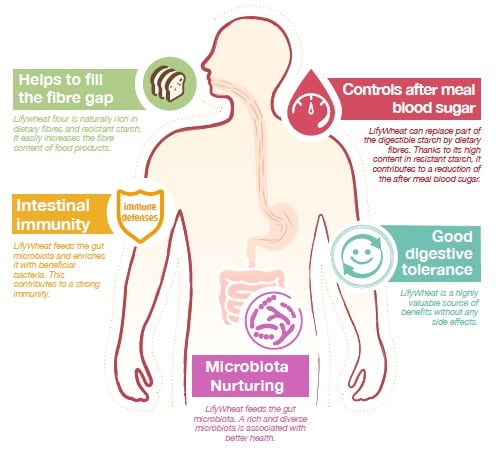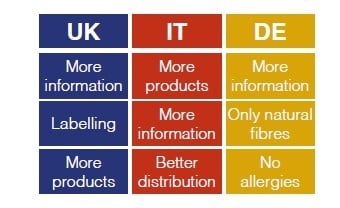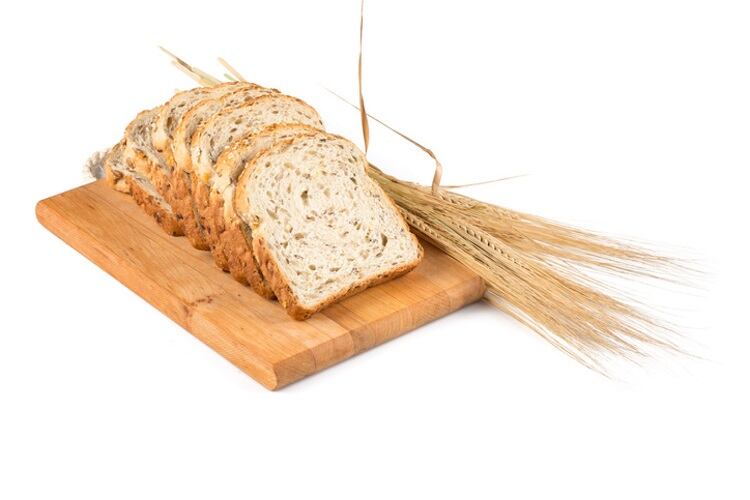According to Limagrain Ingredients – a subsidiary of Limagrain, an agricultural cooperative owned by French farmers and an international seed group – LifyWheat provides a practical response to finally plug the fibre gap.
Daily fibre recommendations for Europeans
For adults: This varies from 25g to 35g per day, depending on the European country.
For children: The values are based on their daily energy requirements and therefore vary with age and gender, from around 15g/d for 4-6 year-olds to 21g to 30g/day for adolescents.
Dietary fibres are part of the large carbohydrate family, such as whole grain cereals, fruits and vegetables, characterised by their inability to be digested in the small intestine.
It is widely known that consumers around the globe do not consume enough fibre daily, despite its recognised health benefits. Throughout Europe, too, national dietary surveys find the fibre intake of consumers is well below the recommended amount. In fact, the gap between ‘what should be’ and ‘what is’ is today considered a major Public Health issue.
Limagrain Ingredients’ revolutions new flour is poised to change the playing field, being naturally rich in dietary fibres (10 times more than common white wheat), 80% of which are resistant starch. LifyWheat also feeds the gut microbiota with beneficial bacteria, contributing towards a healthy gut and immunity system – two top consumer priorities today.
It also presents good digestive tolerance, meaning that it can be eaten by most consumers without adverse side effects and will not affect that taste or texture of a product.
And if that’s not enough, thanks to its high resistant starch content, it contributes to a reduction of the after meal blood sugar.

Consumer study of dietary fibre preception and understanding
To coincide with the launch, Limagrain Ingredients has introduced the ‘Eat Fibre, Feel Better’ campaign to drive home the importance of fibre. It is also at the heart of a consumer study of dietary fibres – in collaboration with the CREDOC (Centre de Recherche pour l’Etude et l’Observation des Conditions de vie) – that is renewed every three years.
The aim of the observatory is to update both the perception and hard-and-fast knowledge surrounding fibre, and the consumption habits of fibre-rich products among different European populations.
The scientific advisory board was led by Dr Véronique Braesco, an agronomic engineer from ENSA Rennes with a specialisation in food science and nutrition, a former research director at INRA (National Institute for Agronomic Research) and an alum of the Danone Group, designing scientific strategies to support the Group’s nutrition and health positioning.
She headed a team of four European experts with complementary expertise in the field of dietary fibre, including Martine Champ, a senior scientist at INRA and the director of the Human Research Centre of Nantes (France) before setting up a consulting company in nutrition; Dr Petra Louis, a senior research fellow at the University of Aberdeen Rowett Institute (Scotland); Dr Denise Robertson, a reader in nutritional physiology at the University of Surrey in the UK; and Dr Stefano Renzetti, a senior scientist and project leader at Wageningen Food & Biobased Research in the Netherlands.
According to Dr Braesco, a high intake of dietary fibres has consistently been associated with lower risks of mortality and lower risk of diseases, such has cardiovascular diseases, diabetes, obesity and colon cancer, due to their varied properties that include slowing down digestion, but primarily their fermentable character.
“Indeed, fibres are not digested in the upper gut and are fermented in the colon, where they nurture the gut microbiota and favour the production of metabolites with many health-promoting benefits,” said Dr Braesco.
She added that not all fibres are the same, but particularly highlighted the importance of resistance start in reducing the carbohydrate response to meals.
“Resistant starch is efficiently fermented in the gut: it’s a good substrate for bacteria to produce short-chain fatty acids, which are able to regulate many functions in the gut and beyond. And all this with no undesirable symptoms, as resistant starch is very well tolerated, even at high doses.”
The role fibre plays
The study was carried out in two phases:
A qualitative survey was conducted amongst 100 online consumers in the UK, Italy and Germany to capture the cultural differences between European countries about fibre and on the expectations of fibre-containing foods. This was followed by a quantitative approach, surveying 7,000 respondents across the UK, France, Germany, Italy, Spain, the Netherlands and Sweden.
According to Anne Lionnet, business developer in charge of LifyWheat, the first stage of the observatory found that the respondents who took time to fully complete the questionnaire are “nutritionally conscious people. This helps to explain certain trends. These results are no less rich: they confirm the interest of our European awareness campaign on fibres and the relevance of our new innovative ingredient.”
It also revealed that food plays a key role in Europeans’ daily lives, with some subtle differences.
In Italy, for example, eating is strongly associated with moments of sociability; in Germany, taste and pleasure play a key role; while in the UK, consumers tend to go for quality over cost and remain more suspicious of processed foods.
Nevertheless, all three countries prioritised health as the top benefit of food.
The health benefits of fibre are widely known with all respondents pointing to benefits like digestion, weight management and the health of the immune system, which it is why it is so surprising that there is a low general knowledge of fibres across the board.
Broadly speaking, fibre is instinctively associated with wholegrains – oats, barely, wheat, bran, spelt – but also vegetables, legumes and potatoes and to a lesser extend fruits such as oranges or nuts. However, there is a big divide on the different fibre types, and more prevalently, how to incorporate it in the daily diet.
Further study results:
- Fibre is most often associated with wholegrain products that have not been processed or artificially modified.
- Participants presume wholegrain flours are high in fibre but are not certain. Nearly half of the respondents would be happy to each enriched products.
- Fibre-enriched foods are mostly associated with breakfast and in some cases, with the main meal of the day (wholegrain pasta).
- Most consumers do not associate a specific colour with the amount of fibre, apart from being brown or light coloured.
- Respondents in all three countries have relatively little knowledge of resistant starch, perceiving it to have the same health benefits as dietary fibre. However, with the exception of British respondents who say they would be tempted to purchase a product if the info of its effects on blood sugar were highlighted, most say that resistant starch would not sway a purchasing decision.
- Bran is most widely the best-known dietary fibre type: 88% of Italians, 61% of Germans and 76% of British consumers mentioned bran, against respectively 24% of Italians, 16% of Germans and 23% of British for resistant starch. That being said, most would appreciate if this info was clearly labelled, clear and easy to understand.
- Questioned about nutrition labelling and dietary messages like ‘rich in’ and ‘source of’, the respondents were split in their perceptions. Half admitted to paying very little attention, believing these to be fake or that the product is naturally virtuous so does not need to label dietary claims. The other half believe these messages play an important role in choosing a product, especially for those with health problems or those looking to improve their well-being.
- Another key finding is that respondents associate fibre with microbiota and the positive impact of high-fibre products on their gut health.
Where to from here?

To increase personal fibre consumption, the observatory found that consumers suggested an improvement of taste; labelling of health benefits (better knowledge about the recommended daily intake and other related health benefits; and emphasis that fibre is ‘naturally’ present in the product and not of the processed or refined variety.
To conclude, almost four in 10 respondents are looking for additional information on the health benefits of food-fibre.
Limagrain Ingredients has positioned LifyWheat to be part of this health approach, by providing a practical, accessible and easy concept to help Europeans increase their fibre intake. Like any other wheat flour, LifyWheat can be used in a wide range of applications like bread, pasta, biscuits and breakfast cereals.





